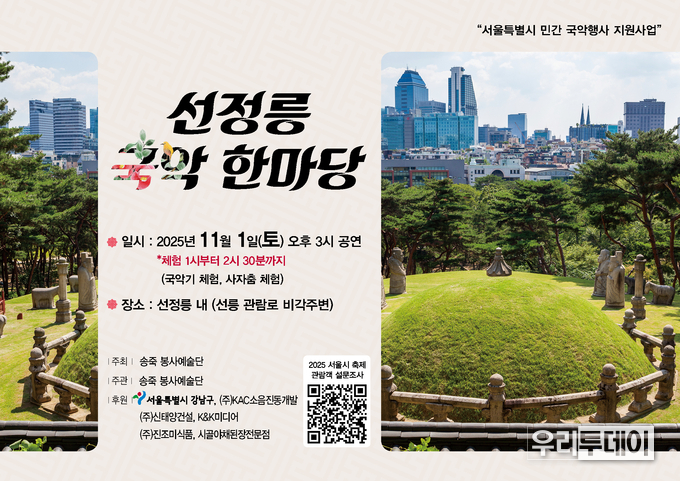
우리투데이 이동현 기자 | 송죽 봉사예술단(회장 김상순)은 2025년 11월 1일 서울특별시 강남구에 위치한 선정릉내에서 '선정릉 국악 한마당' 행사를 한다고 보도자료를 통해 밝혔다.
이번 행사는 송죽 봉사예술단이 주최.주관하며, 서울특별시, 강남구, (주)KAC소음진동개발, (주)신태양건설, K&K미디어, (주)진조미식품, 시골야채된장전문점이 후원한다.
한국판소리 백일성악회 총회장 조상현 국창은 축하말을 통해 "오늘의 축제 '선정릉 국악한마당'은 오랜 세월 우리 조상들의 얼과 혼이 깃든 소리를 오늘의 시대와 마음으로 되살리는 예술의 향연입니다. 선정릉은 조선의 성군으로 일컬어지는 성종대왕의 예악 정신이 서린 곳입니다. 그 정신이 이 무대를 통해 다시 깨어나 우리 모두의 마음속에 고요한 울림으로 전해지리라 믿습니다. 이 자리를 정성껏 마련해주신 김상순 송죽예술봉사단 대표님과 단원 여러분 그리고 헌신적으로 함께해주신 관계자 여러분께 깊은 감사와 따뜻한 격려의 말씀을 드립니다. 여러분의 노력이야 말로 우리 국악의 뿌리를 지키고 그 꽃을 다시 피워내는 귀한 손길입니다"라고 전했다.
또한 서울특별시의회 김형재 서울시의원(국민의힘, 강남2선거구)은 "서울특별시의회 문화체육관광위원회에서 의정활동 중인 김형재 의원입니다. 금번 행사는 2025년도 서울시 민간국악행사지원사업 공모에서 우수 프로그램으로 평가받아 선정된 것을 축하드리며, 김상순 지부장님 회원님들과 함께 기쁨을 나눌 수 있게 된 점에 대해서도 감사의 말씀을 전합니다"라며, "예악(禮)의 정신이 서린 왕릉에서 우리의 전통음악을 시민과 함께 나누는 일은, 유산의 보존을 넘어 오늘의 일상과 미래를 잇는 소중한 문화적 실천이라고 할 수 있습니다.
아울러 김상순 지부장님을 비롯한 오늘 행사 개최를 위해 정성을 다해 준비해 주신 송죽예술봉사단 관계자 여러분께 깊이 감사드립니다. 그리고 김상환 총괄회장님, 박용례 후원회장님, 신이나 예술단장님, 김경숙사무총장님, 노은주 총 예술감독님을 비롯한 모든 출연진과 스태프의 헌신에 대해 박수를 보내며, 저 역시 서울시의회 문화체육관광위원으로서 시민이 생활속에서 예술을 누릴 수 있도록 문화시설 확충, 예술인이 창작에 전념할 수 있는 공정하고 지속 가능한 지원체계, 그리고 도시의 품격을 높이는 문화유산의 보존·활용을 적극 뒷받침 하겠습니다"라고 전했다.
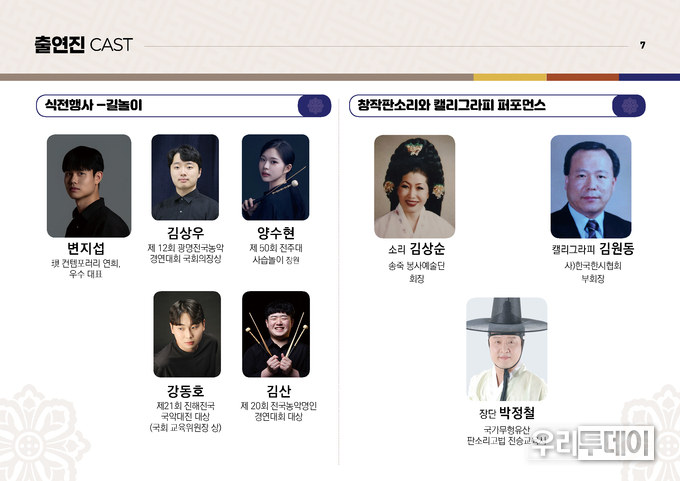
이날 식전행사는 길놀이로 시작되는데 풍물 '길놀이'는 한국의 전통적인 연희 문화인 풍물놀이(농악) 중 하나로, 축제나 행사의 시작을 알리고 분위기를 고조시키며 행사장 일대를 정화하고 성역화(聖化)하는 의례적 성격을 가진 중요한 순서이다.
꽹과리, 징, 장구, 북, 소고 등의 악기를 치고 춤을 추며 정해진 길을 따라 행진한다.
이어 첫번째는 선정릉가 창작판소리와 캘리그라피 퍼포먼스를 통해 판소리의 역동적인 장단과 소리꾼의 드라마틱한 감정선에 맞춰, 캘리그라피 작가는 '역사', '평화', '안녕' 등 선정릉이 상징하는 핵심 단어들을 현장에서 즉흥적으로 써내려갈것으로 보여지며, 두번째 대금 '청성곡(靑城曲)'은 조선 후기 궁중음악 중 하나로, 국악기로 연주되는 대표적인 정악(正樂) 곡이다. '청성(靑城)은 푸른 산성, 즉 고요하고 신성한 공간을 뜻한다. 학문과 예술을 중시했던 성종과, 예악의 사상을 번성시켰던 중종이 계시는 신성한 공간에서 예를 갖춘 청성곡이 울려퍼질것이다.
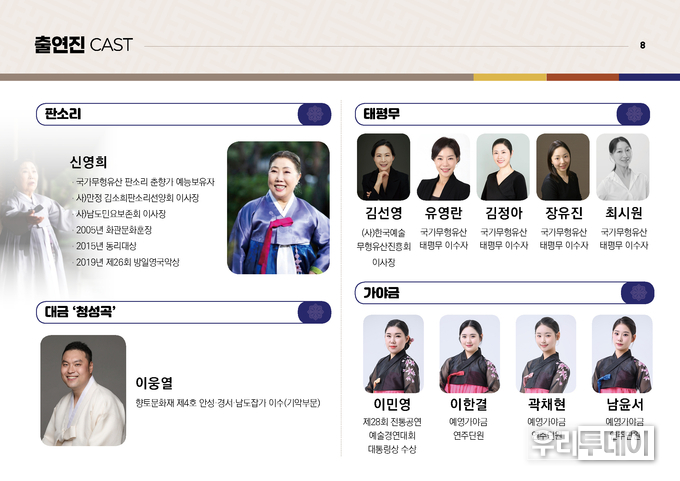
세번째는 태평무(太平舞)로 나라의 태평성대를 기원하며 추어지는 전통무용으로, 왕의 덕을 찬양하고 세상의 평화를 바라는 뜻을 담고 있다. 조선 후기 궁중무의 형식을 바탕으로 민속적 요소가 결합된 이 춤은, 왕실 제례의 장엄함과 백성의 소망을 함께 담아낸 예술이다. 왕과 왕비의 안식을 기리고 그 덕을 추모하는 공간인 선정릉에서 추는 태평무는 그 덕이 세상에 미쳐 나라가 평화롭기를 바라는 몸짓이라 할 수 있다.
네번째로 판소리 '사랑가'는 선정릉은 조선 시대 성종 정현왕후·중종의 능으로, 조선의 왕과 왕비의 사랑과 인연이 깃든 장소이다. 판소리 〈춘향가〉의 ‘사랑가’는 남녀 간의 사랑을 노래하지만, 단순한 연정이 아니라 신의(信義)와 정절, 인간적 도리를 담고 있다. 다섯번째는 가야금(伽倻琴)으로 신라 시대부터 이어진 우리 고유의 현악기지만, 조선에 들어서면서 궁중 음악에도 사용되었습니다. 특히 성종대(成宗代)는 예악(禮樂)을 중시한 시기였고,궁중의 음악 제도가 크게 정비되었다. 고요한 능역의 분위기 속에서 울려 퍼지는 가야금의 선율은, 조선 왕조의 평화와 조화의 정신을 상징적으로 표현한다.
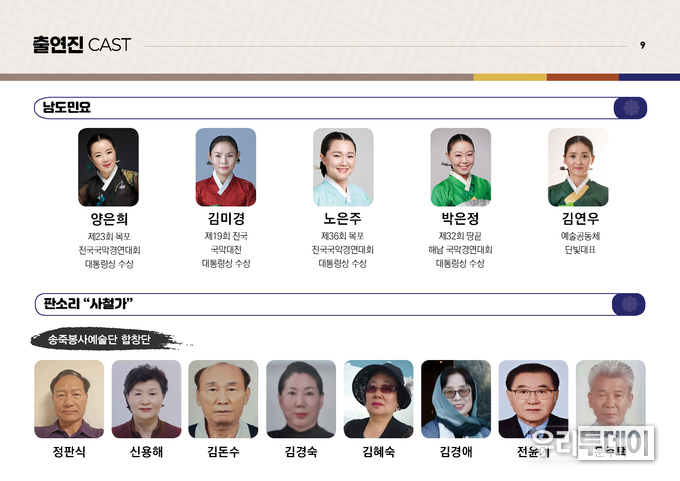
이어 여섯번째는 판소리 '사철가'로 판소리 동호인 합창을 통해 단가 '사철가(四節歌)' 선정릉의 사계(四界) 속에서, 인생의 의미를 노래하다. '이산 저산 꽃이 피니~'으로 시작하는 '사철가는 봄의 아름다움부터, 녹음짙은 여름, 단풍 드는 가을, 흰 눈 내리는 겨울까지 사계절의 아름다운 풍경을 묘사한다.그러나 그 아름다움 뒤에는 세월의 덧없음과 인생의 무상함이라는 깊은 성찰이 담겨 있다. 수백 년의 시간을 넘어선 선정릉의 고요한 숲속에서, 동호인들이 한마음으로 부르는 ‘사철가’ 합창은 이곳에 잠든 왕들의 삶의 궤적과 더불어, 이 자리에 모인 우리 모두의 인생의 의미를 되새겨보는 깊은 울림을 선사할 것이다.
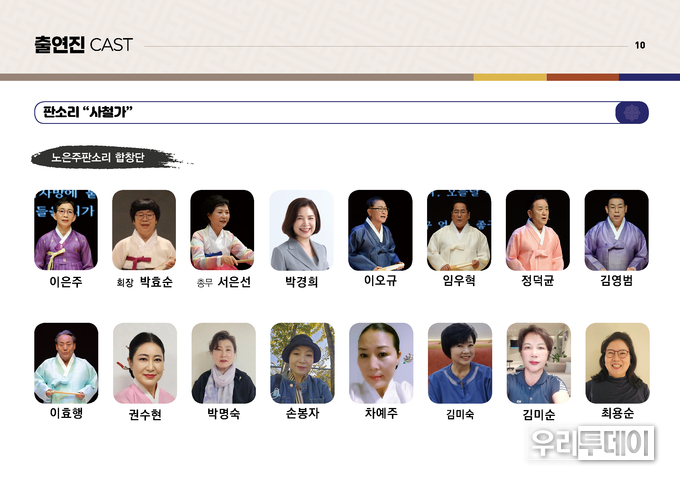
일곱번째는 북청사자로 왕릉의 안녕을 빌고, 이 땅의 평안을 기원하는 벽사진경(辟邪進慶)의 춤으로 국가무형유산 '북청사자놀음은 함경남도 북청 지역에서 정월 대보름 즈음에 행해지던 대표적인 민속놀이이다.
이 놀이의 중심에 있는 사자(獅子)는 예로부터 ‘악한 기운을 물리치고(벽사, 辟邪), 경사로운 일을 불러오는(진경, 進慶)' 영물로 숭배되었다. 잡귀를 쫓는 용맹함으로 사자탈을 쓴 연희자들이 역동적이고 힘찬 춤을 추며, 왕릉 주변에 남아있을지 모를 잡귀와 재앙을 몰아내고 선정릉의 영원한
안녕을 기원하는 의미를 담고 있다.
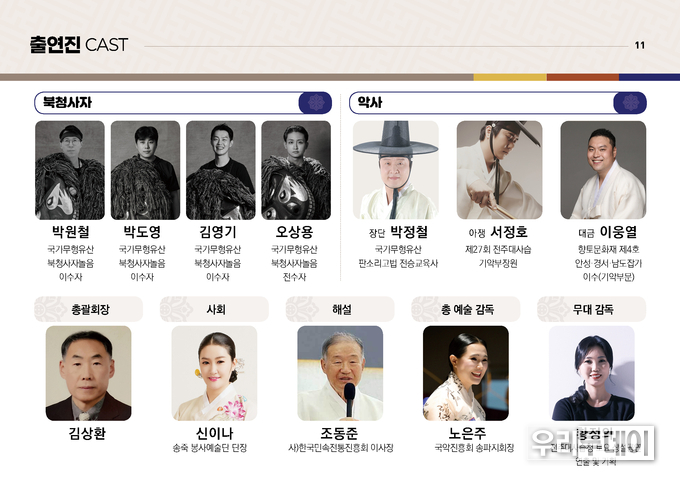
여덟번째는 남도민요 '새타령'과 서울삼각산 '진도아리랑'으로 조선의 왕릉은 풍수에 따라 산과 물, 숲, 새소리가 어우러지는 자리에 세워졌고, 그 안에서는 인간과 자연이 조화롭게 공존하는 ‘예(禮)의 공간'으로 여겨졌다.
새타령의 흥겨움은 왕조의 위엄을 부드럽게 감싸며, 도심 속에서도 여전히 살아 있는 조선의 자연미학을 느끼게 할 수 있다.
마지막으로 관객과 다함께 '아리랑', '강강술래'로 대미를 장식할 계획이다.
민족의 애환을 넘어 희망으로, '아리랑' 합창이 진행될 예정이다. ‘아리랑’은 수많은 시련 속에서도 꿋꿋하게 삶을 이어온 우리 민족의 애환과 강인한 생명력이 담겨 있는 노래이다. 수백 년의 세월을 견뎌온 선정릉의 왕릉처럼, ‘아리랑은 굴곡진 역사를 넘어 오늘날까지 이어져 온 한국인의 변치 않는 정서를 상징한다. 선정릉의 고즈넉한 숲속에서 울려 퍼지는 우리의 ‘아리랑'은 과거와 현재를 잇는 평화의 노래가 될 것이다.
김상순 회장은 인사말을 통해 "이번 선정릉 국악 한마당 행사는 전통과 현대가 어우러지는 문화의 장으로 우리 단원 한 분 한 분의 땀과 열정 그리고 묵묵히 뒤에서 애써주신 김상환 총괄회장님, 박용례 후원회장님, 신이나 예술단장님, 김경숙 사무총장님, 노은주 총 예술감독님, 송죽예술봉사단 단원들의 헌신이 있었기에 가능했습니다"라며, "특히 오랜시간 예술의 현장을 지켜온 문화재선생님과 기량이 풍부한 예술인 여러분의 참여는 오늘 축제를 한층 더 품격있게 만들어 주었습니다"라고 밝혔다.
이어 "여러분의 혼과 열정이 모여 이 무대가 서울의 가을을 수놓는 감동의 시간으로 남을 것이라 믿습니다. 앞으로도 송죽예술봉사단은 시민 곁에서 예술의 나눔과 문화의 향기를 전하며 서울의 품격 있는 문화도시 구현에 힘쓰겠습니다"라고 전했다.
김상순 회장은 (사)한국판소리보존회 강남 지부장을 맡고 있으며, 국가무형유산 판소리 이수자이며, 2006년 대한민국 시사예술 평화대상수상 국제발전공로평화대상을 비롯해 2007년 전국 종합예술 경연대회 남도민요 일반부 최우수상, 2009년 전국 종합예술 경연대회 판소리 부분 대상, ·2013년 자랑스런 한국인대상, 상명전통문화발전공로대상, ·2014년 문화예술교육사 자격증 취득(문화체육관광부장관), 2015년 UN 한국 참전국 친선협회 감사장 수여, 2019년 전국판소리대회 명창부 대상수상(문체부장관상), 평화통일 봉사상 수상, 육탄용사선양회 백선엽대장 감사장 수상, 이진삼대장 공로상 수상, 태국왕실 국왕대리인 반딧대장 감사장 등을 받기도 했다.
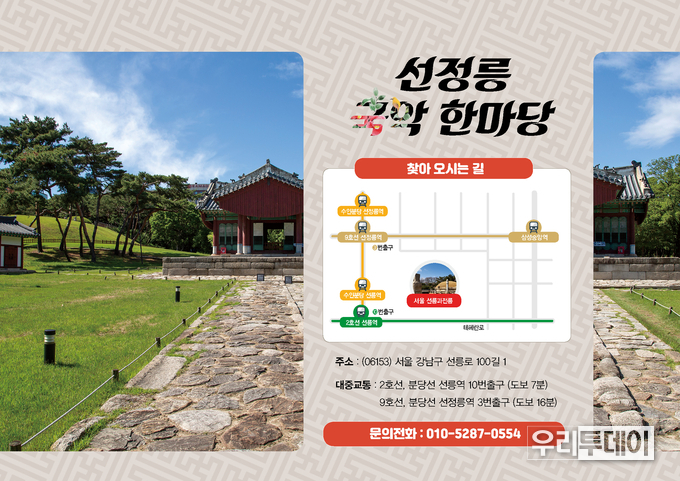
The Songjuk Volunteer Art Troupe (Chairman Kim Sang-soon) announced via press release that it will hold the ‘Seonjeongneung Traditional Music Festival’ event on November 1, 2025, within Seonjeongneung Royal Tomb in Gangnam-gu, Seoul.
This event is hosted and organized by the Songjuk Volunteer Art Troupe, with sponsorship from the Seoul Metropolitan Government, Gangnam-gu, KAC Noise & Vibration Development Co., Ltd., Shin Taeyang Construction Co., Ltd., K&K Media, Jinjomye Food Co., Ltd., and the Country Vegetable Soybean Paste Specialty Store.
In his congratulatory remarks, Master Jo Sang-hyeon, President of the Korean Pansori Baekil Seongak Association, stated, "Today's festival, the ‘Seonjeongneung Traditional Music Festival,’ is an artistic celebration that revives the sounds imbued with the spirit and soul of our ancestors over many years, bringing them to life with the spirit and heart of our times. Seonjeongneung is a place steeped in the spirit of ritual and music of King Seongjong, hailed as a virtuous monarch of the Joseon Dynasty. I believe that spirit will awaken anew through this stage, resonating as a quiet echo in all our hearts. I extend my deepest gratitude and warm encouragement to Ms. Kim Sang-soon, representative of the Songjuk Art Volunteer Group, and all its members who prepared this venue with such dedication, as well as to all the officials who have devotedly supported us. Your efforts are the precious hands that preserve the roots of our traditional music and make its flowers bloom once more."
Additionally, Seoul Metropolitan Council Member Kim Hyung-jae (People Power Party, Gangnam District 2) stated, "I am Council Member Kim Hyung-jae, serving on the Seoul Metropolitan Council's Culture, Sports, and Tourism Committee. I congratulate this event on being selected as an outstanding program in the 2025 Seoul Metropolitan Government's Private Traditional Music Event Support Project competition. I also express my gratitude for the opportunity to share this joy with Branch Director Kim Sang-soon and the members." "Sharing our traditional music with citizens at royal tombs imbued with the spirit of ritual (禮) is a precious cultural practice that transcends heritage preservation, connecting today's daily life with the future.
I also deeply thank Branch Director Kim Sang-soon and all members of the Songjuk Art Volunteer Group who devoted their efforts to preparing today's event. I applaud the dedication of Chairman Kim Sang-hwan, Support Chairwoman Park Yong-rye, Artistic Director Shin In-a, Kim Kyung-sook, Secretary General, and Noh Eun-joo, Chief Artistic Director, along with all performers and staff. As a member of the Seoul Metropolitan Council's Culture, Sports, and Tourism Committee, I will actively support the expansion of cultural facilities so citizens can enjoy art in their daily lives, establish a fair and sustainable support system enabling artists to dedicate themselves to creation, and preserve and utilize cultural heritage to elevate the city's dignity."
The pre-ceremony event begins with a street parade. The traditional Korean folk music performance known as ‘Gilnori’ is part of the folk music and dance tradition (Nongak), serving as an important ritual sequence that announces the start of a festival or event, heightens the atmosphere, and purifies and sanctifies the surrounding area.
Performers march along a designated path, playing instruments such as the kkwaenggwari, jing, janggu, buk, and sogo while dancing.
Following this, the first segment features a creative pansori performance and calligraphy art at Seonjeongneung. Synchronized with the dynamic rhythms of pansori and the dramatic emotional lines of the singer, the calligrapher will spontaneously write key words symbolizing Seonjeongneung—such as ‘history,’ 'peace,' 'peace', and ‘well-being’—key words symbolizing Seonjeongneung—in an impromptu on-site calligraphy session. The second piece, the ‘Cheongseonggok’ (Blue Fortress Melody), is a representative court music (jeongak) piece performed with traditional Korean instruments, originating from late Joseon dynasty court music. ‘Cheongseong’ (Blue Fortress) signifies a tranquil and sacred space. This dignified piece will resonate within the sacred space where King Seongjong, who valued scholarship and the arts, and King Jungjong, who fostered the philosophy of ritual and music, rest.
The third piece is the Taepyeongmu (太平舞), a traditional dance performed to pray for the nation's era of peace and prosperity. It embodies the meaning of praising the king's virtue and wishing for world peace. Based on the form of late Joseon court dance but incorporating folk elements, this dance embodies both the solemnity of royal rites and the aspirations of the people. Performed at Seonjeongneung, a space honoring the rest of the king and queen and commemorating their virtues, the Taepyeongmu is a gesture expressing the wish that their virtues spread throughout the world, bringing peace to the nation.
Fourth, the pansori ‘Love Song’ (Sarangga) is performed at Seonjeongneung, the royal tomb of Queen Jeonghyeon, consort of King Seongjong, and King Jungjong. This site embodies the love and karmic bonds between Joseon kings and queens. The ‘Love Song’ from the pansori Chunhyangga sings of romantic love between a man and woman, yet it transcends mere passion to embody loyalty, fidelity, and human virtue. Fifth is the gayageum (伽倻琴), a traditional Korean string instrument dating back to the Silla Dynasty, which also found its way into court music during the Joseon period. The reign of King Seongjong (成宗代) was a time that emphasized ritual music (禮樂), and the court music system underwent significant reorganization. The melody of the gayageum, resonating within the tranquil atmosphere of the royal tomb complex, symbolically expresses the spirit of peace and harmony of the Joseon dynasty.
Next, the sixth piece is the pansori ‘Sacheolga’. Through a pansori enthusiasts' chorus, the single song ‘Sacheolga’ sings of the meaning of life amidst the four seasons at Seonjeongneung. Beginning with “Flowers bloom on this mountain, that mountain~,” the “Four Seasons Song” depicts the beautiful landscapes of all four seasons: the beauty of spring, the lush greenery of summer, the autumn foliage, and the snowy winter. Yet, behind this beauty lies a profound reflection on the fleeting nature of time and the impermanence of life. Amid the tranquil forest of Seonjeongneung, which has stood for centuries, the chorus of ‘The Four Seasons Song’ sung in unison by fellow enthusiasts will resonate deeply. It will reflect not only the life trajectories of the kings resting here but also prompt us all gathered in this place to contemplate the meaning of our own lives.
The seventh is the Bukcheong Lion Dance, a ritual dance performed to ward off evil spirits and bring good fortune, praying for the peace of the royal tombs and the prosperity of the land. It is a National Intangible Cultural Heritage. The Bukcheong Lion Dance is a representative folk performance traditionally held around the first full moon of the lunar new year in the Bukcheong region of South Hamgyong Province.
The lion at the heart of this play has been revered since ancient times as a sacred creature that 'wards off evil spirits (辟邪, biksha) and brings auspicious events (進慶, jingeong).' Performers wearing lion masks dance dynamically and powerfully, embodying the lion's courage in chasing away evil spirits. This ritual aims to expel any lingering malevolent forces or disasters around the royal tombs and pray for the eternal peace of Seonjeongneung.
The eighth is the Namdo folk song ‘Saetarryeong’ and Seoul's Samgaksan ‘Jindo Arirang’. Joseon royal tombs were built in locations harmonizing mountains, water, forests, and birdsong according to feng shui principles, regarded as ‘spaces of ritual’ where humans and nature coexisted harmoniously.
The joyful spirit of Saetarryeong gently envelops the dynasty's dignity, allowing one to feel the enduring natural aesthetics of Joseon even within the city.
Finally, the finale will feature the audience joining together in singing ‘Arirang’ and ‘Ganggangsullae’.
Transcending the nation's sorrows, the ‘Arirang’ chorus will proceed as a song of hope. ‘Arirang’ embodies the sorrows and resilient vitality of our people, who steadfastly carried on life through countless trials. Like the royal tombs of Seonjeongneung that have endured centuries, ‘Arirang’ symbolizes the unchanging spirit of Koreans that has persisted through a turbulent history to the present day. Our ‘Arirang,’ resonating through the tranquil forest of Seonjeongneung, will be a song of peace connecting the past and the present.
In his opening remarks, Chairman Kim Sang-soon stated: “This Seonjeongneung Traditional Music Festival was made possible by the dedication of each member of our troupe, their sweat and passion, and the tireless efforts behind the scenes of Chairman Kim Sang-hwan, Patron Chairman Park Yong-rye, Artistic Director Shin In-a, Secretary General Kim Kyung-sook, Chief Artistic Director Noh Eun-joo, and the members of the Songjuk Artistic Volunteer Group.” “The participation of our cultural heritage masters, who have long safeguarded the artistic tradition, and our talented artists, whose skills are rich and diverse, has elevated the dignity of today's festival.”
He continued, "I believe the spirit and passion gathered here will make this stage a moving moment that adorns Seoul's autumn. Moving forward, the Songjuk Art Volunteer Group will continue to share art and the fragrance of culture with citizens, striving to realize Seoul as a city of refined culture."
Chairman Kim Sang-soon serves as the head of the Gangnam branch of the Korea Pansori Preservation Society.
Chairman Kim Sang-soon serves as the head of the Gangnam branch of the Korea Pansori Preservation Society. He is a certified practitioner of Pansori, a National Intangible Cultural Heritage. His awards include the 2006 Korea Current Affairs Arts Peace Grand Prize for International Development Merit and Peace, the 2007 Grand Prize in the General Division for Namdo Folk Songs at the National Comprehensive Arts Competition, the 2009 Grand Prize in the Pansori Division at the National Comprehensive Arts Competition, ·2013 Proud Korean Award, Sangmyung Traditional Culture Development Merit Award, ·2014 Cultural Arts Education Certificate (Ministry of Culture, Sports and Tourism), 2015 UN Korean War Veterans Friendship Association Certificate of Appreciation, 2019 Grand Prize in the Master Singer Division at the National Pansori Competition (Ministry of Culture, Sports and Tourism Award), Peace and Unification Service Award, Certificate of Appreciation from the General Baek Seon-yeop Association for Honoring Brave Soldiers, Certificate of Merit from General Lee Jin-sam, Certificate of Appreciation from His Majesty the King of Thailand's Representative, General Ban Dit, among others.
